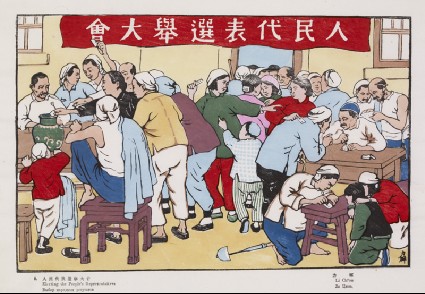Chinese Prints 1950-2006 in the Ashmolean Museum
A catalogue of the Ashmolean’s collection of Chinese prints from 1950-2006 by Weimin He and Shelagh Vainker (published Oxford, 2007).

Publications online: 129 objects
- Reference URL
Actions
Part of...
Electing the People's Representatives
-
Literature notes
I feel life is a big intangible competition, we compete for achievement, compete for contribution, compete for health and compete for longevity…
During his long career, Li Qun has witnessed and participated in the development of modern Chinese printmaking over a period of some 70 years. In the 1930s, under Lu Xun’s (1881–1936) influence and encouragement, Li started to produce woodcuts. In 1931, Li was admitted to the Hangzhou National Art School and in 1933 organized the Woodcut Research Association. In 1940 he arrived in Yan’an, where he took up teaching at the Lu Xun Academy of Literature and Arts. In 1949 he was appointed Chairman of the Shanxi Provincial Artists’ Association, moving back to Beijing in 1953 to act as editor of Meishu (Art). His early work absorbed folk art elements, depicting the hard social conditions of old China and the development and construction of new China. He adopted the ideas of serving the masses and serving socialism as the guidelines of his art throughout his life. A museum of Li Qun’s art opened in 2005 in his hometown of Lingshi. -
Details
- Series
- (New) New Year Pictures Collection
- Associated place
-
Asia › China › Hebei province › Beijing (place of publication)
- Date
- published 1950
- Artist/maker
-
Li Qun (1912 - 2012) (artist)
- Associated people
-
New Rongbaozhai (established 1949) (publisher)International Bookstore (established 1949) (retailer)
- Material and technique
- multi-block woodcut, printed with water-soluble ink
- Dimensions
-
mount 55.7 x 40.5 cm (height x width)
print 20.2 x 29.1 cm (height x width)
- Material index
- Technique index
- Object type index
- No. of items
- 1
- Credit line
- Purchased, 2006.
- Accession no.
- EA2006.277
-
Further reading
Weimin He, and Shelagh Vainker, Chinese Prints 1950-2006 in the Ashmolean Museum (Oxford: Ashmolean Museum, 2007), no. 9 on p. 14, p. xi, illus. p. 14
Location
-
- currently in research collection
Objects are sometimes moved to a different location. Our object location data is usually updated on a monthly basis. Contact the Jameel Study Centre if you are planning to visit the museum to see a particular object on display, or would like to arrange an appointment to see an object in our reserve collections.
Publications online
-

Chinese Prints 1950-2006 in the Ashmolean Museum
I feel life is a big intangible competition, we compete for achievement, compete for contribution, compete for health and compete for longevity…
During his long career, Li Qun has witnessed and participated in the development of modern Chinese printmaking over a period of some 70 years. In the 1930s, under Lu Xun’s (1881–1936) influence and encouragement, Li started to produce woodcuts. In 1931, Li was admitted to the Hangzhou National Art School and in 1933 organized the Woodcut Research Association. In 1940 he arrived in Yan’an, where he took up teaching at the Lu Xun Academy of Literature and Arts. In 1949 he was appointed Chairman of the Shanxi Provincial Artists’ Association, moving back to Beijing in 1953 to act as editor of Meishu (Art). His early work absorbed folk art elements, depicting the hard social conditions of old China and the development and construction of new China. He adopted the ideas of serving the masses and serving socialism as the guidelines of his art throughout his life. A museum of Li Qun’s art opened in 2005 in his hometown of Lingshi.
Notice
Object information may not accurately reflect the actual contents of the original publication, since our online objects contain current information held in our collections database. Click on 'buy this publication' to purchase printed versions of our online publications, where available, or contact the Jameel Study Centre to arrange access to books on our collections that are now out of print.
© 2013 University of Oxford - Ashmolean Museum


